I went through the $150 PCR test in Nicaragua and now it’s clear; I need to get through Honduras and El Salvador within 72 hours. Otherwise, I’ll end up paying an additional $80 in Honduras and $35 in El Salvador.
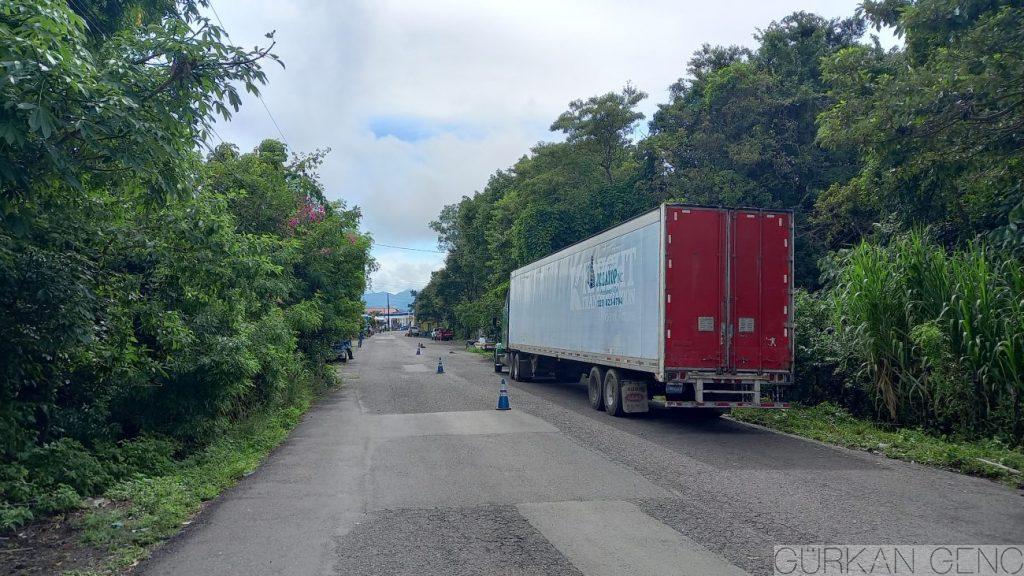
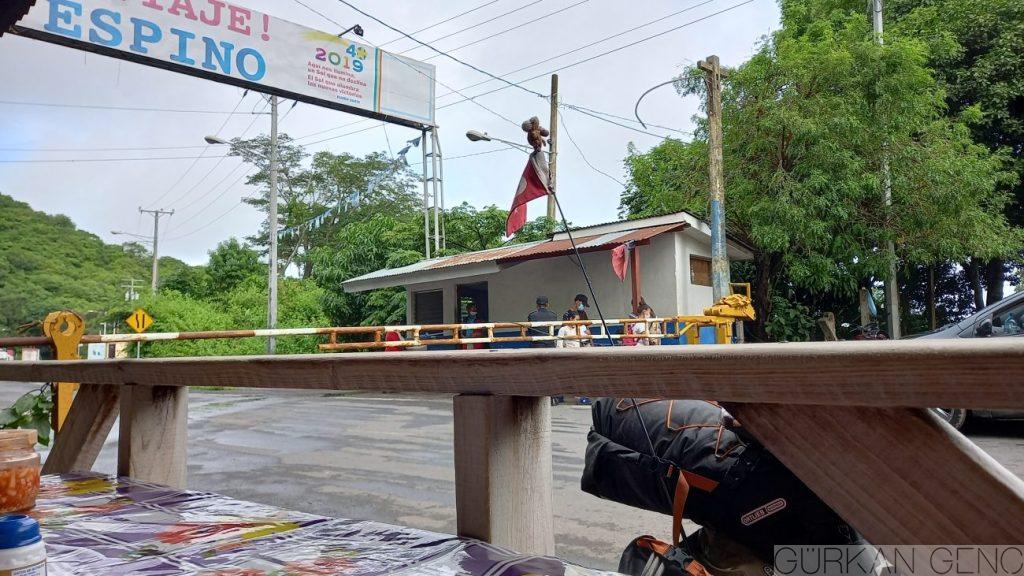
I left the hostel early in the morning. It was 30 km to the Honduras border, and the road was quite enjoyable. Since it was a Sunday, there was no one else on the road besides me. I really enjoy moments like this. The border crossings were also quite easy. The roads in Honduras were better than expected, with a safety lane. I only stopped once to get water, and the person who gave me water didn’t ask for any money. If you were to ask me what I think about Honduras, I’d say nothing.
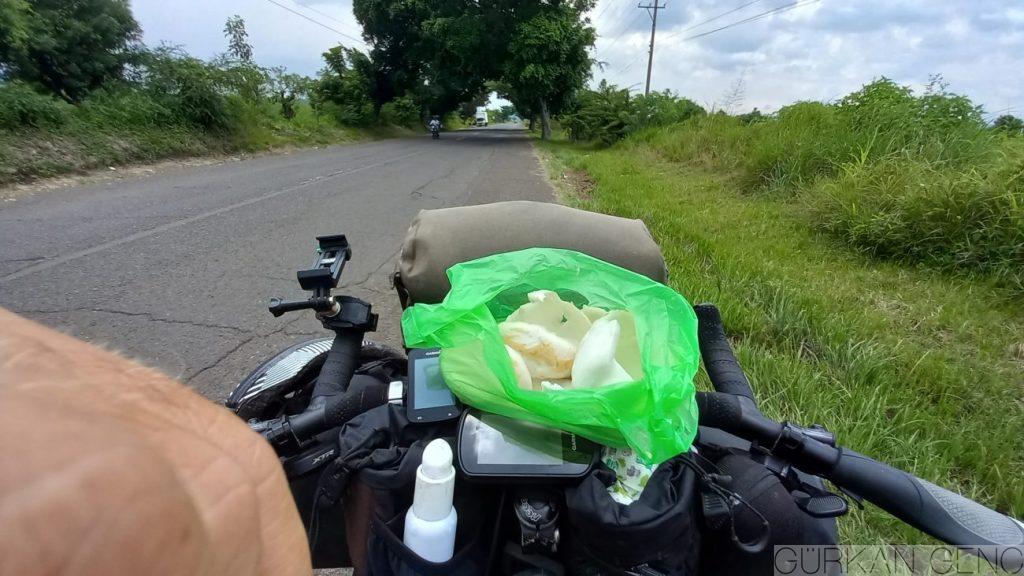
In front of my handlebar, there was coconut flesh. Many cyclists doing a tour of Central America pass through this country in one or two days at most. It’s worth mentioning that this country is more pristine compared to other Central American countries. The scenery in Honduras, both on the Pacific and Atlantic coasts, is beautiful. This is a country where you can get the cheapest courses or education in surfing, diving, Spanish, and other subjects in Latin America. I don’t know if I’ll travel around Honduras in the future. Maybe I’ll stop by to import coffee, although that’s a small possibility. Let’s see what the future holds.
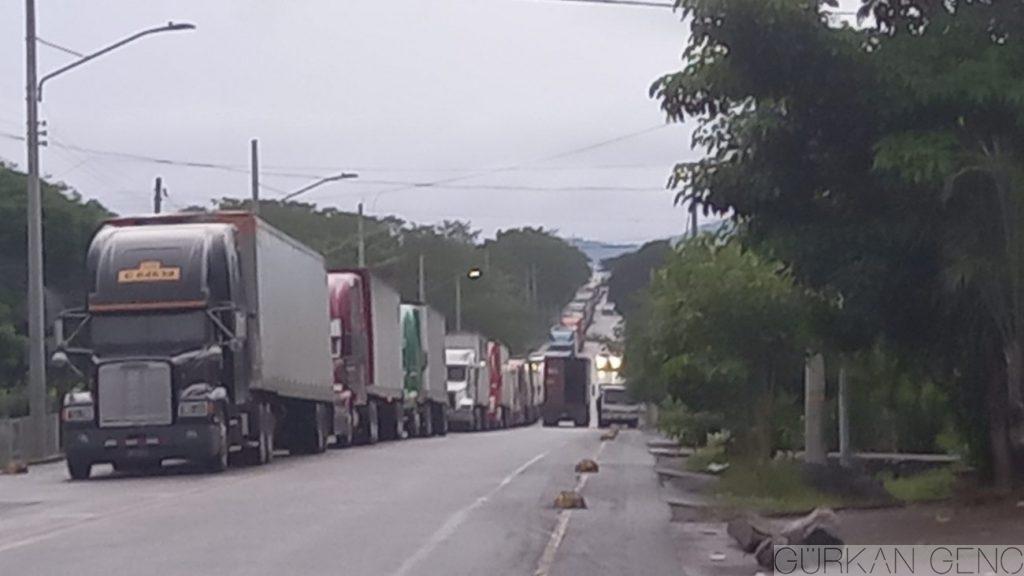
I had no trouble at the El Salvador border crossing either. However, there was an interesting procedure. When I arrived at the border, the officers asked for photocopies of my PCR test and passport. When I told them I didn’t have them with me, they directed me to a store just past the border that had a photocopy machine. It seemed like someone was being given a favor. Provide the wifi password from the cabin, so I can take photos of both documents with my phone and email them or send them as a PDF. Then archive them wherever you like. This use of paper is a waste, causing environmental pollution, loss of time, and economic loss for the customer. If you were to ask who benefits, it starts with the owner of the photocopy machine and extends upwards. This is the busiest route connecting North and South America through Central America… Anyway, I completed the procedures and as I was doing so, it started raining again. It would’ve been nice to stay dry.

As I was about to enter El Salvador, it was getting dark. I appreciated the presence of truck stops along the road and the safety lane was fantastic. I was very surprised to see the roads in such good condition upon entering this country. I’ve never liked traveling at night. In total, I’ve pedaled over 120,000 km in 12 years across 68 countries. If you asked me how many times I’ve traveled at night, I would confidently say less than 10 times. I only continued with these nighttime journeys out of necessity. Why don’t I ride at night?
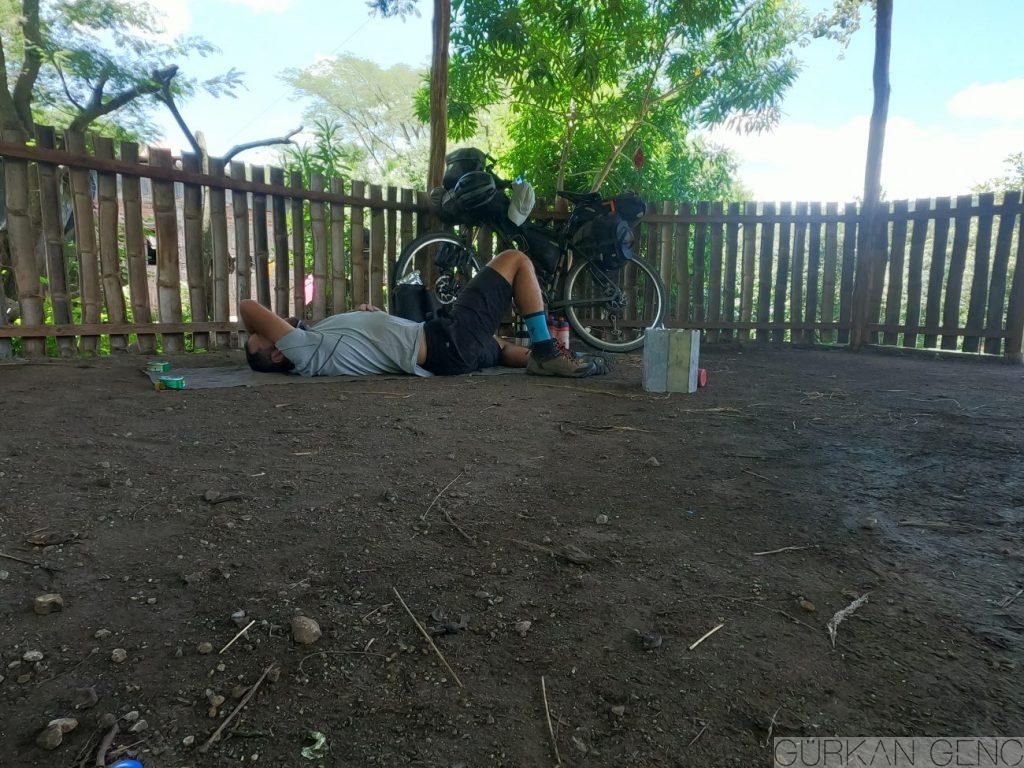
– The number of drivers who drink alcohol after work and get behind the wheel is higher at night.
– My field of view is limited at night. I like to see the surroundings and understand the geography I’m passing through. I don’t want to be confined to the area illuminated by my lights.
– I use the electricity generated by the dynamo for other things. I can’t charge my headlamp and bike lights every evening.
– When I set up my tent, I want to see the surroundings of the area.
– If I’m traveling on highways or country roads at night, I increase the risk of being robbed.
The negative situations listed above might not happen when I travel at night, but even a 1% risk can affect my world tour. Riding a fully loaded bike at night significantly increases the risk. This is why I haven’t done night rides for the past 12 years. Because of this, my first accommodation in El Salvador was at a truck stop.
El Salvador became known as the country that adopted Bitcoin as its official currency. It was the first country to take such a decision, attracting the attention of many people involved in Bitcoin…
– “Gürkan, what do you think about the use of Bitcoin in the country?”
– “What are your thoughts on the country? Can you live there? Can we find work?”
– “What are your thoughts on Bitcoin?”
I’m not someone who deals with Bitcoin, so I don’t know how to spend it or where to buy and sell it. But it’s clear that virtual currencies will be used in the future. Whether it’s Bitcoin or another virtual currency, I don’t know. Let me share my Bitcoin story:

In 2019, while cycling in Chile, I lost my ID and went to the embassy. I know our diplomats in the Chilean embassy quite well. They invited me in and we chatted while I explained how I lost my ID. They served me Turkish coffee and delight. Just as I took a sip of coffee, one of the staff, Recep, said:
– “Gürkan, there’s an arrest warrant for you!”
– “What…?”
I spat the coffee out onto myself. We laughed at first, thinking it was a joke, but they then said there really was an arrest warrant and they couldn’t process my application. We were all shocked. What on earth was this about? Anyway, I immediately contacted my lawyer friends in Turkey. Thanks to İlker, he was very helpful. It turned out there was a file for me at the Eskişehir Prosecutor’s Office. Why? Here’s the story:
In 2018, I returned to Turkey to see my late father for the last time. During that brief period, a photo was taken of us at Atılım University in jeans and shirts. I don’t even have the original photo. The scammers found this photo where I was photographed with academic staff. They cut out the people around me, placed a company logo on the wall behind us, and yes, as you might have guessed, it was a Bitcoin company. Then they used my photo to scam people out of tens of thousands of dollars. Once the scammers disappeared, people managed to track me down using that photo. A year before this incident, I had received threats from people demanding their money back. I couldn’t understand what was happening. I told them, “Someone scammed you, talk to my lawyers in Turkey, we’ll go to the prosecutor together.” But they insisted that I pay them in cash. Seeing that the threats wouldn’t stop, I filed a complaint. Once I filed the complaint, the threats and messages stopped. Eventually, someone filed a complaint against me with the prosecutor’s office. Since the prosecutor couldn’t reach me, an arrest warrant was issued. My residence? Oh, the world tour, my residence changed so many times. Bahrain, South Africa, Chile, Colombia, Guatemala… These are just the ones I can remember. So, since the prosecutor couldn’t reach me, an arrest warrant was issued. And I only found out about it after losing my ID in Chile.
It was like an absurd comedy. Lawyer İlker requested a meeting with the prosecutor. He explained who I was, what I had done, and presented the original, unaltered photo. Then my statement was sent from Chile to Turkey. Imagine returning to your country, going through the airport, and being taken straight to a police station. It was a big lesson. Before I end my world tour and enter my final country, Iran, I plan to visit our embassy and check my GBT (criminal record).

So, that’s my Bitcoin adventure. However, it’s a widely accepted and commonly used currency in today’s world. What did I observe regarding Bitcoin in El Salvador? From the point I entered the country until I left, I only used cash, and the currency was the US dollar. I only found banks to withdraw cash when I entered towns. I didn’t see any businesses that accepted credit or debit cards outside the capital. The hostel I stayed at in the capital accepted credit cards, but the commission was high, so I preferred to pay in cash. There were very few businesses that accepted Bitcoin cards for transactions, especially outside the capital. This is worth noting. As of September 2021, people used Bitcoin cards at ATMs to withdraw US dollars and then spent the cash. These ATMs weren’t everywhere, and the ones that existed were well-protected. You rarely find an ATM outside of banks. In El Salvador, you can often see one or two people with pump-action shotguns standing guard in front of every shop. Banks, gas stations, restaurants, pharmacies, large supermarkets, small supermarkets… They’re all guarded by people with shotguns.

In contrast, the hostel street in the capital, San Salvador, was surrounded by barbed wire fences with a gated entrance. Some city streets have been protected against theft in this manner. There are barbed wire fences everywhere. I even saw beggars directing traffic, stopping cars, and asking for money. This was in the city center. Surely, San Salvador must have luxurious, fancy neighborhoods like other large Latin American capitals, but I didn’t see those areas. I stayed in the city for two days, took a PCR test, and then continued my journey.
As I mentioned earlier, El Salvador was one of the Central American countries I passed through quickly, but there were three spots along my route worth visiting. These three locations would be my first introduction to Mayan civilization:
– Joya de Ceren Museum
– San Andres Archaeological Site
– El Tazumal Archaeological Site
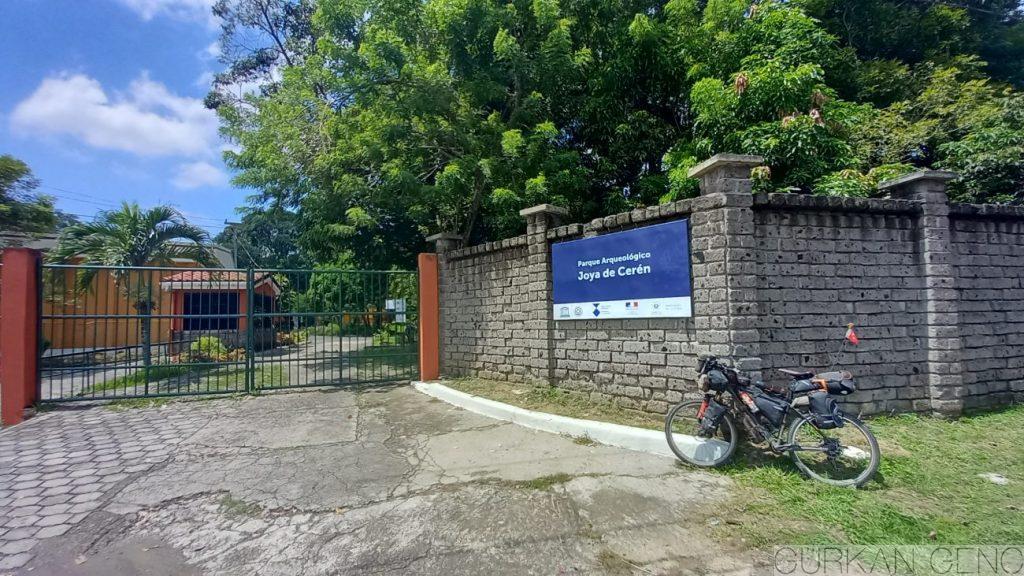
1 – I went as far as the gate of Joya de Ceren. However, due to COVID-19 measures, the site was closed during the time I visited, in August 2021. Thus, I couldn’t encounter the Mayan civilization at the first stop on my journey. This is perhaps the most important historical site in the country, which is also protected by UNESCO. Established around AD 500, the city was abandoned after the eruption of the Loma Volcano, which is one kilometer away from the city. Although they haven’t found human bodies buried under the volcanic ash during the excavations, Italian archaeologists call this area the Pompeii of America. Many valuable items buried under the ash still haven’t been fully unearthed. Despite ongoing excavations since the 1960s, internal conflicts, corruption, and other reasons have prevented the area from being fully showcased to the present day, and the excavations are still ongoing. Am I surprised? No, I’m not. I haven’t researched or read about the parliamentary structure, education, health, or other issues in El Salvador. But I can somewhat anticipate what I might find if I did.
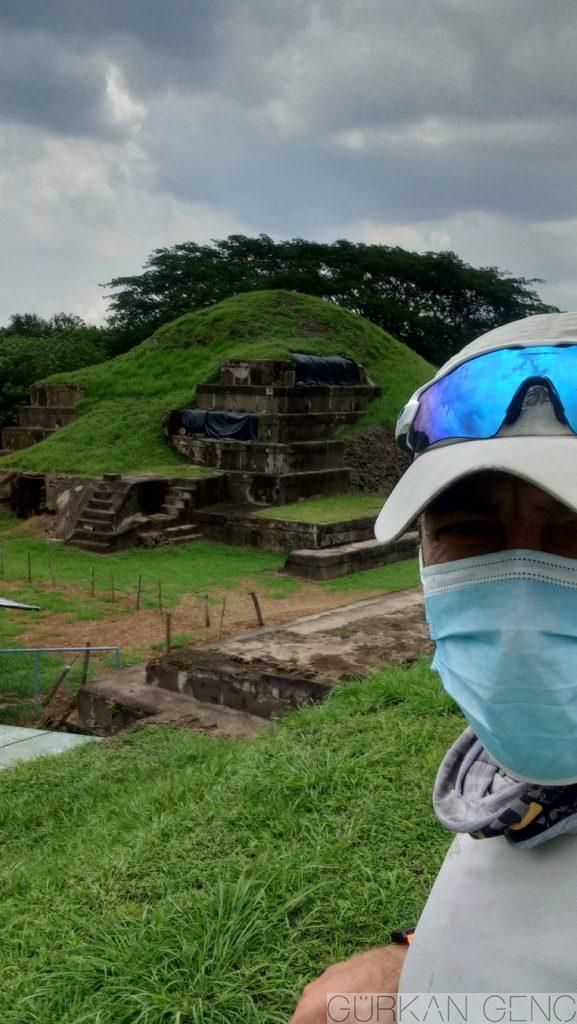
2 – I managed to enter the San Andres Archaeological Site. There were no tourists from other countries inside, and it would have been difficult during the COVID-19 period. During the time I visited, visitors from abroad were required to have a PCR test or be vaccinated to tour the site. Since I had a PCR test done before leaving El Salvador, I could enter with that document. There’s not much visually appealing in this area. There are two structures above ground. In my opinion, there may be more structures under the two wooded areas. The excavations here also have not progressed as expected. The temporary shelters built by American archaeologists show signs of fire on either side. So, I believe this area was damaged during the internal conflicts of ’89-’90. I don’t think the country’s authorities support archaeological excavations.
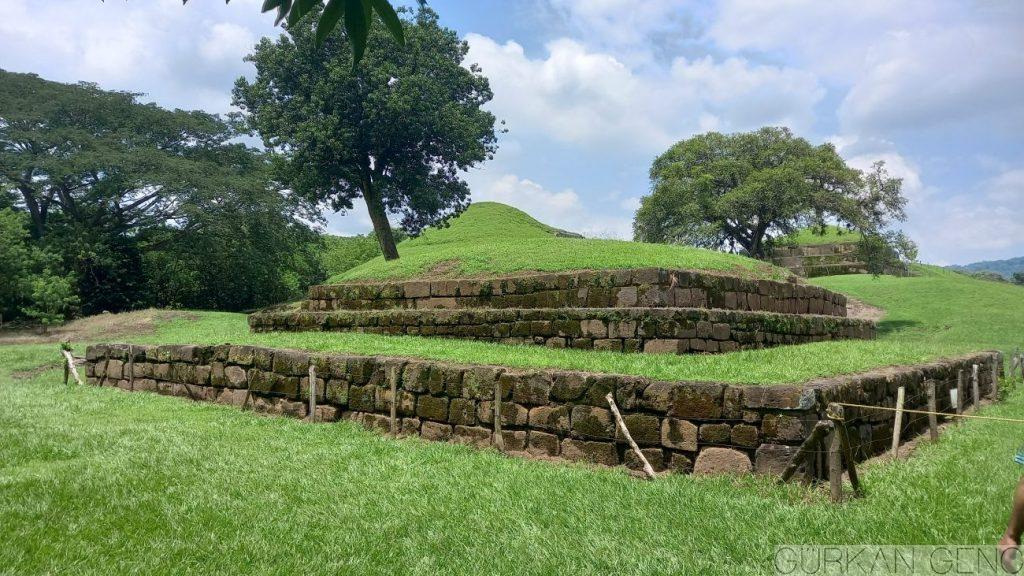
These excavations are likely carried out with support from other states. You’re going to conduct archaeological excavations in the country, while the faculty members face the risk of being caught in internal conflicts or robbery. Even today, there are few countries or private sectors willing to send archaeologists to El Salvador as support. The situation in the capital is evident, with armed guards everywhere. How will you protect the staff, teachers, and their belongings in these areas outside the city center? Due to these reasons, it is clear that the excavations in the region have not been extensive or detailed, as shown by the areas discovered. Those who read my articles know that I enjoy visiting archaeological sites, and I believe that if the area near these sites is excavated, there could be significant findings. They talk about the 6th century BC. Furthermore, according to the findings, it might be one of the largest settlements in the region because remains of goods sent from Mayan settlements in present-day Mexico and Belize have been discovered here. The unearthed areas were places where people gathered and worshipped in the past, and it’s evident that some of them are still buried underground. However, I enjoyed walking around the area and sitting near the ceremonial grounds to observe my surroundings. It’s likely that if they excavated where I sat, something would still emerge.
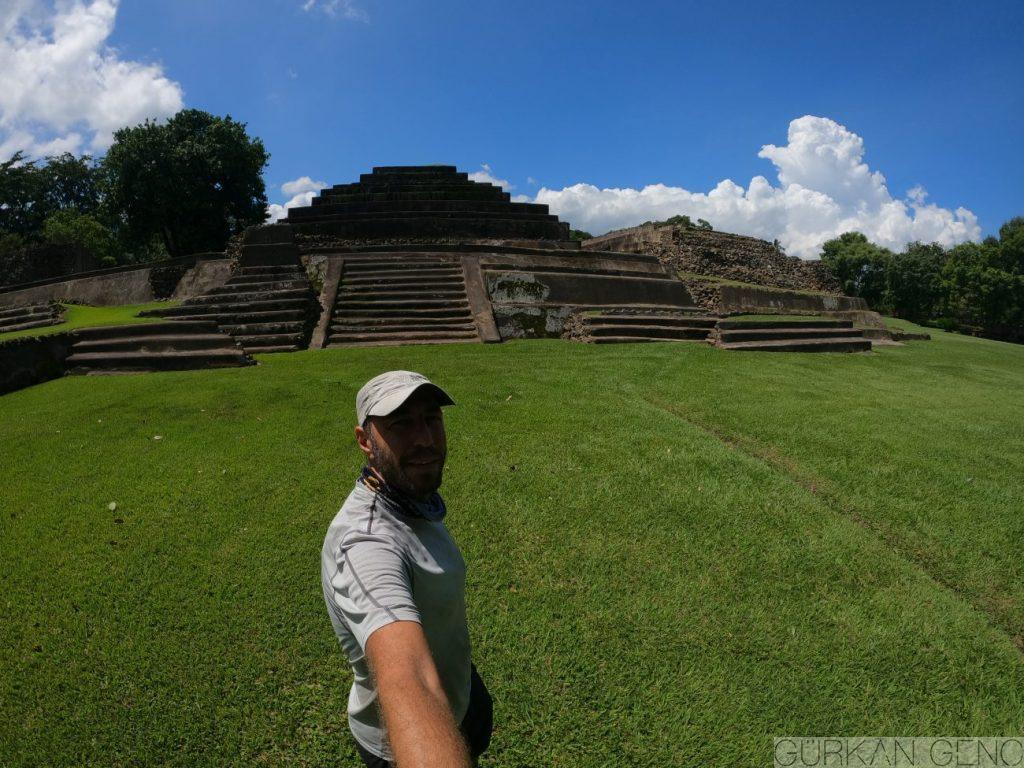
3 – The El Tazumal Archaeological Site is located within the town of Chalcuhapa, which is also 38 kilometers from the Guatemalan border. Since I arrived in the town in the evening, the most important task was to find a place to stay. I first checked the ioverlander app to see where travelers last stayed in 2019. I’ve mentioned several times in live broadcasts that I use this program a lot. Why do I say where people stayed in 2019? Because so few travelers remained in Latin America between 2019-2021 that hardly any data was entered into the app. The only new data I’ve seen in the last two years has come from myself. Few people seem to have stayed in the town; two hotels were visible. Google showed four hotels, all located on the road, so I checked them out one by one and found that all were closed. Since no tourists come to town, all the hotels had closed.
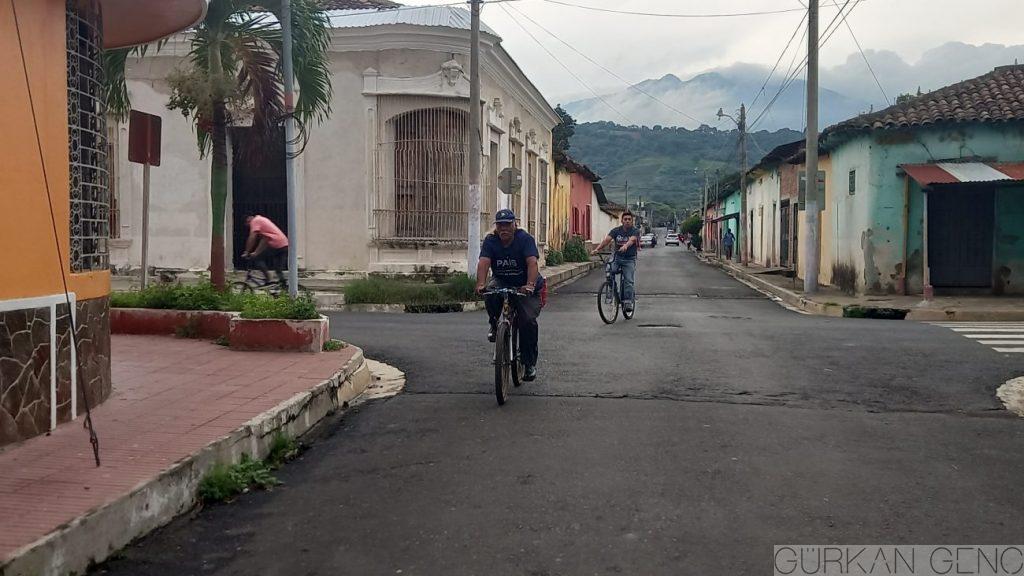
Given the situation, I went to the police and explained it to them. They were surprised and didn’t believe me at first. One said, “No way, follow us and we’ll take you to a hotel.” A whole police station, and this is not something I haven’t done before, “Should I pitch a tent here for the night?” I suggested, but they didn’t accept it. We drove around in the police car, checking all the hotels I’d already seen, and ended up back at the police station. You live in such a small town with only four hotels to check, and they only learned that all the hotels had been closed for months thanks to me. All the police were mobilized and looking for a place for me to stay. It became a national issue… A man who travels the world has come to El Tazumal, and there’s no place for him to stay, how can this be? One police officer suggested, “Does it have to be a specific hotel? My friend has a love motel in town. They could host you there.” That’s fine by me; I just need a place to protect my bike and sleep. So, the hotel owner picks me up, and we go to a single-story building with three garages and three rooms on the edge of town.
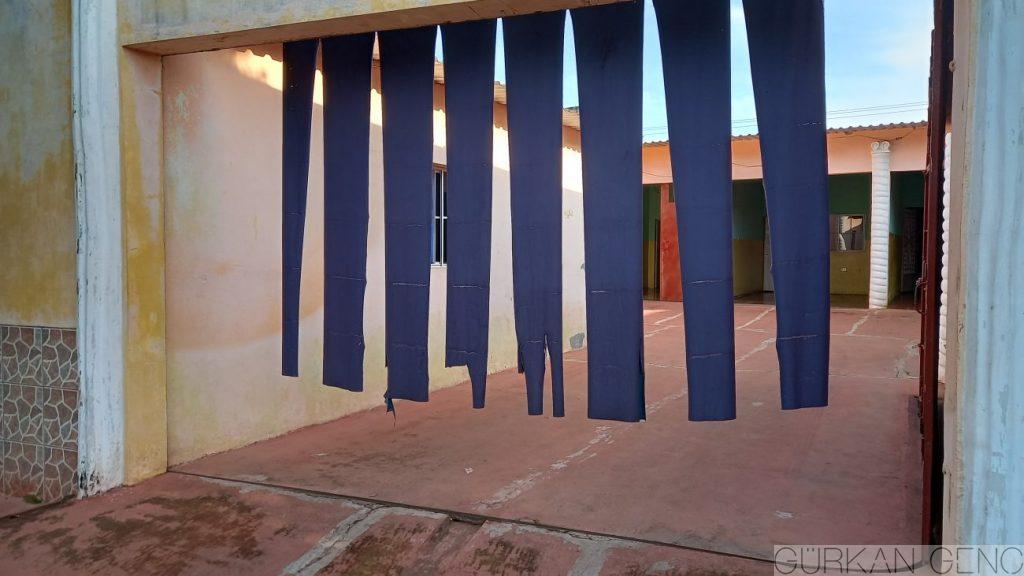
This is a MOTEL where people who can’t make love at home because of their children or couples who can’t find a place to have sex pay for an hour and fulfill their needs. In my 2017 article about Argentina, I mentioned that the word “motel” is used throughout Latin America specifically for these types of sex motels. These motels offer rooms on an hourly basis, from 7:00 am to 6:00 pm, and don’t rent them daily because they make much more money that way. When I arrived, everyone had already finished their business and gone home, so the motel was empty. Another issue is hygiene. The higher-quality motels take hygiene very seriously, while others, like this one, are a disaster. The upside is that once you drive into the garage, you can lock it from the inside, making it a fortress-like space. Everything looks tidy and organized, but it’s clear the bedding hasn’t been changed since the last battle. I set up my tent in the garage, then took a shower and made dinner at the table and chair I pulled up next to my tent. The freedom to sleep anywhere is an extraordinary thing. After years of traveling without a home, it’s incredibly unsettling. Of course, I have certain criteria for this; maybe one day, I’ll compile them in a book.
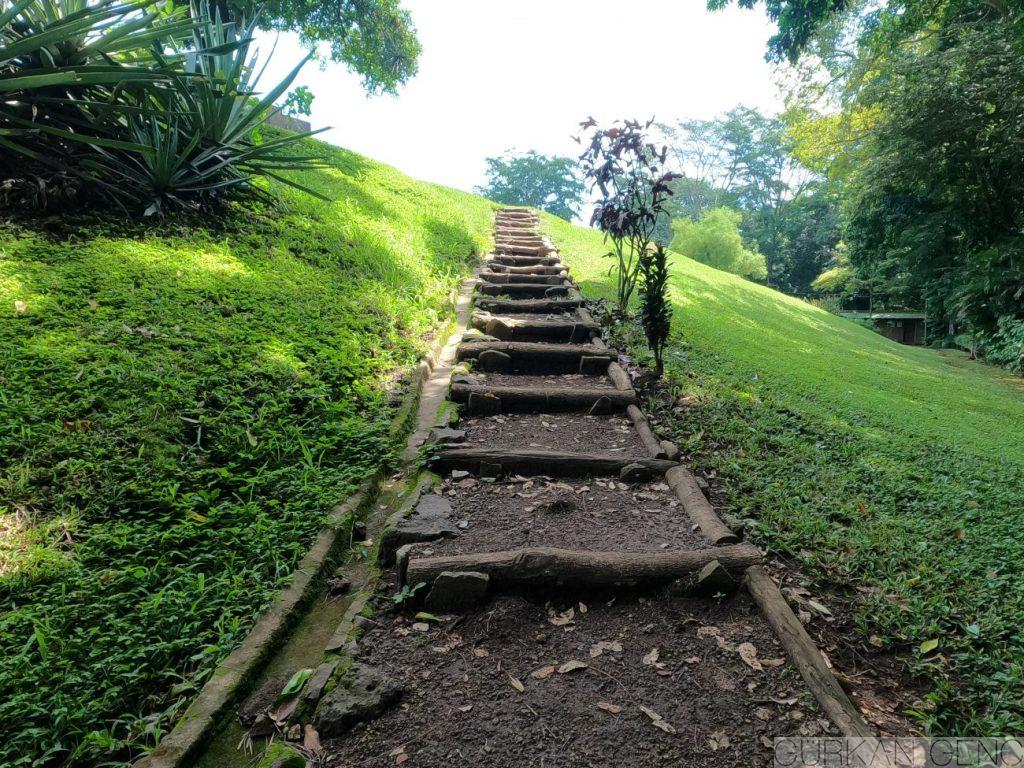
Now, let’s talk about the El Tazumal Maya Temple. This was my first encounter with a Maya Temple in Central America. Excavations in the area have uncovered cemeteries, water drainage systems, a ball game court similar to the one the Mayans played, market areas, and gathering places. People lived around this temple between AD 100 and 1200, and it was later abandoned. The reason for the city’s abandonment was neither a volcanic eruption nor Spanish soldiers. The temple, 24 meters high, was constructed around AD 100, and it’s estimated that construction of the surrounding structures was completed by AD 800.
The discovery of the site is quite interesting. This massive structure was entirely buried underground. The earth used by the people living in the area where the current town is located was taken from this region. One day, as earth was being excavated, a part of the structure emerged. In the 1940s, this small mound evolved into the temple’s current form. Much of the restoration work done during that period was constructed directly with concrete to protect the structure from being destroyed by the public, allowing it to survive to the present day. All the valuable items found here were sent to the national museum in the capital. Although current-day archaeologists criticize the restoration work, it is clear that decisions were made based on the circumstances of the time. Similar situations occurred in the past in our country, and I’ve mentioned them in my earlier memories.
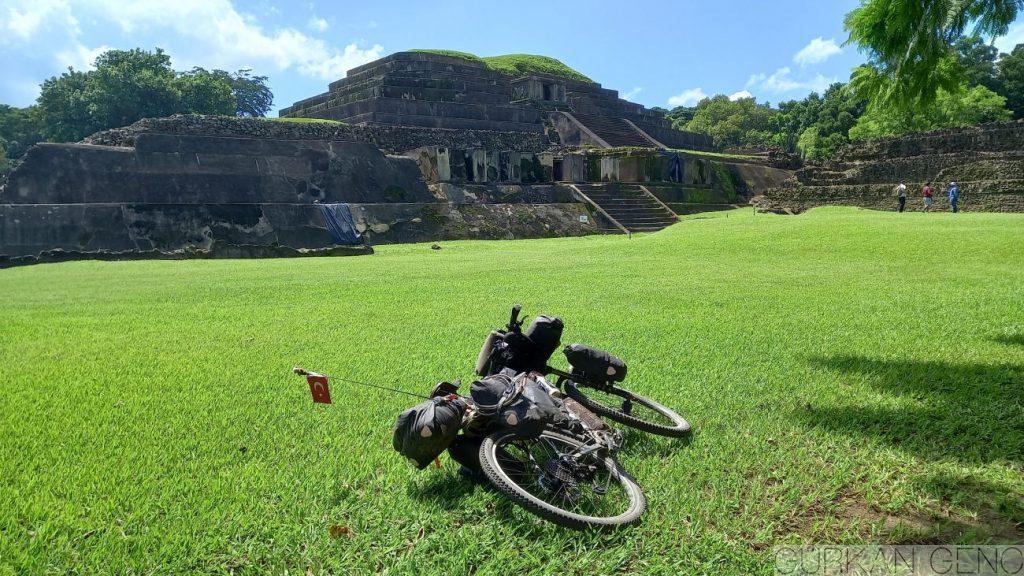
There was a very nice area in front of the temple, with benches for sitting. I put on my headphones and played one of my favorite songs. Once the music started, it was just the temple and me. My late father would take us to ancient cities in Turkey, and I’d ask him how the people of the time lived, and he’d tell me. As the years went by, I began going to these sites on my own, sitting down to imagine what the people of that time did in the place where I was standing. I’d walk around the area, read the information provided, then move to a nice spot and look at the structure one last time before closing my eyes. (Of course, I don’t close my eyes when I have my bike with me, haha). Then I travel back in time. With my eyes open, you circle the area you know, observing its surroundings until people appear, dressed and speaking in ways left to your imagination.
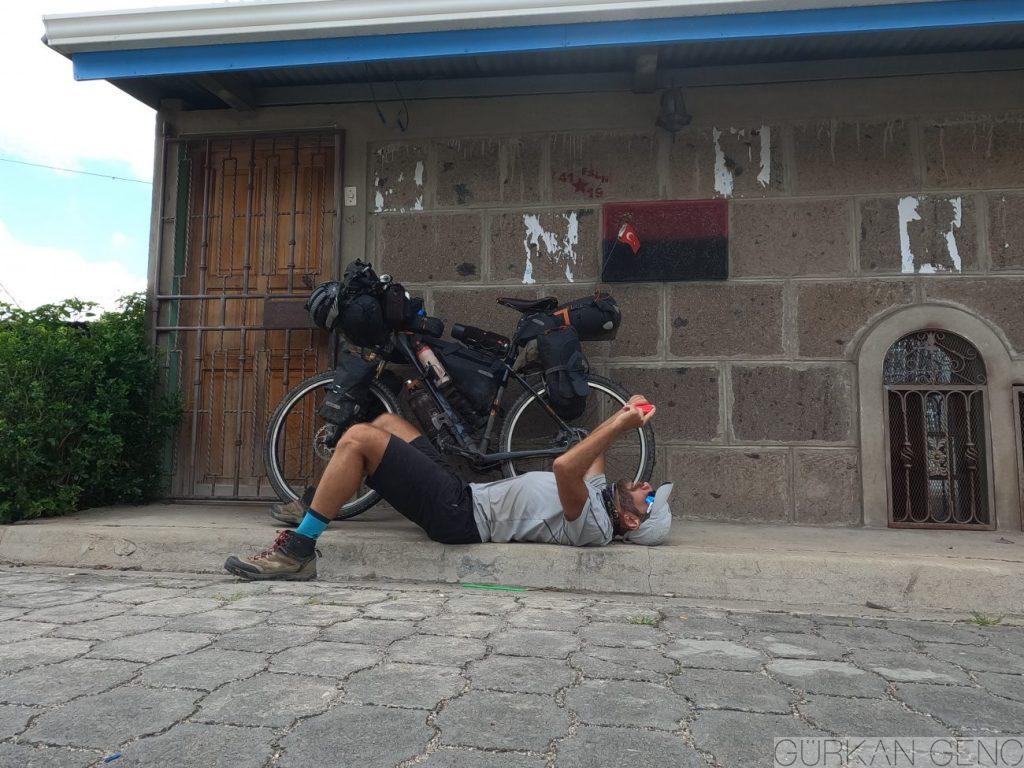
The Guatemalan border was 36 kilometers away from this point. After leaving El Tazumal, the journey was quite peaceful, and I entered the country without any issues at the Guatemalan border. I continued pedaling northward.